Comparative Financial Analysis: Standard Chartered Bank and UOB
VerifiedAdded on 2019/11/14
|33
|7693
|171
Report
AI Summary
This report conducts a comparative financial analysis of Standard Chartered Bank (SCB) and United Overseas Bank (UOB), focusing on key financial ratios to assess their performance. The introduction provides background information on both banks, highlighting their significance in the financial market. The literature review covers financial analysis concepts and the application of financial ratios in banking, including credit loss ratio, cost/income ratio, net interest margin, earnings per share, return on equity, and capital adequacy ratio. The research methodology outlines the research design, data collection methods, and analysis techniques used. The findings section presents and analyzes the financial statements and ratios of both banks, comparing their performance across the selected metrics. The analysis includes detailed discussions on each ratio, providing insights into their financial health and operational efficiency. The conclusion summarizes the key findings and offers recommendations for the banks based on the comparative analysis.
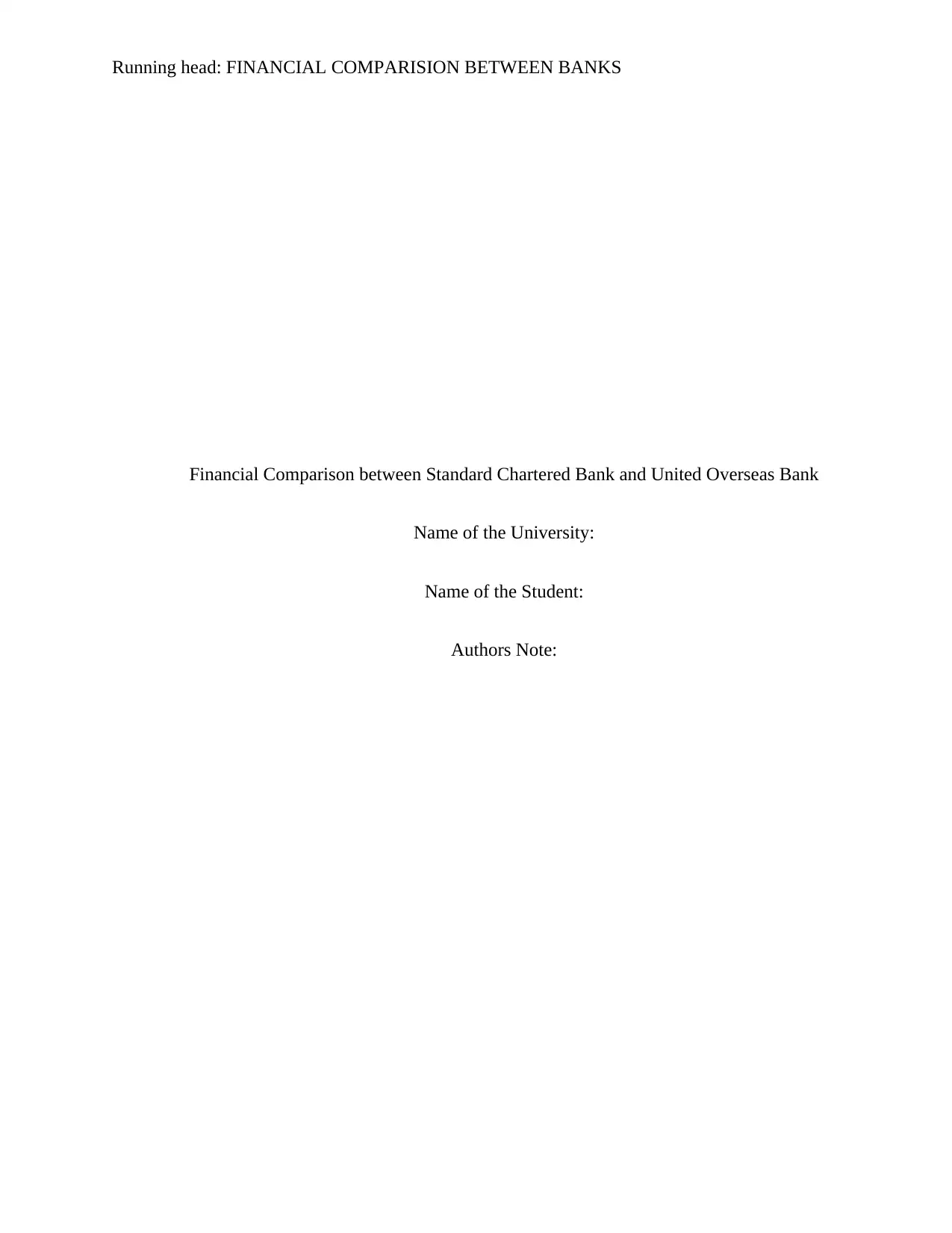
Running head: FINANCIAL COMPARISION BETWEEN BANKS
Financial Comparison between Standard Chartered Bank and United Overseas Bank
Name of the University:
Name of the Student:
Authors Note:
Financial Comparison between Standard Chartered Bank and United Overseas Bank
Name of the University:
Name of the Student:
Authors Note:
Paraphrase This Document
Need a fresh take? Get an instant paraphrase of this document with our AI Paraphraser
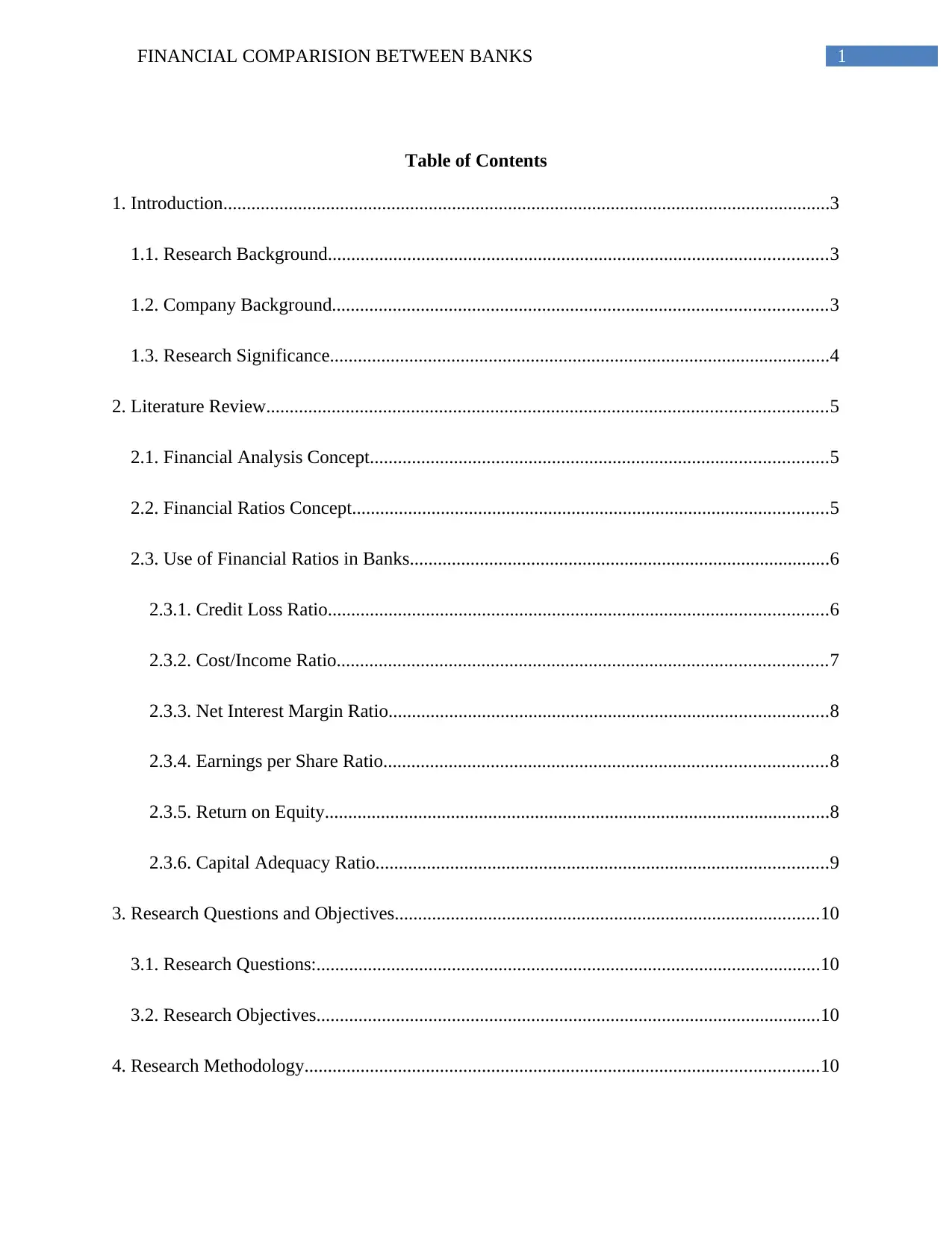
1FINANCIAL COMPARISION BETWEEN BANKS
Table of Contents
1. Introduction..................................................................................................................................3
1.1. Research Background...........................................................................................................3
1.2. Company Background..........................................................................................................3
1.3. Research Significance...........................................................................................................4
2. Literature Review........................................................................................................................5
2.1. Financial Analysis Concept..................................................................................................5
2.2. Financial Ratios Concept......................................................................................................5
2.3. Use of Financial Ratios in Banks..........................................................................................6
2.3.1. Credit Loss Ratio...........................................................................................................6
2.3.2. Cost/Income Ratio.........................................................................................................7
2.3.3. Net Interest Margin Ratio..............................................................................................8
2.3.4. Earnings per Share Ratio...............................................................................................8
2.3.5. Return on Equity............................................................................................................8
2.3.6. Capital Adequacy Ratio.................................................................................................9
3. Research Questions and Objectives...........................................................................................10
3.1. Research Questions:............................................................................................................10
3.2. Research Objectives............................................................................................................10
4. Research Methodology..............................................................................................................10
Table of Contents
1. Introduction..................................................................................................................................3
1.1. Research Background...........................................................................................................3
1.2. Company Background..........................................................................................................3
1.3. Research Significance...........................................................................................................4
2. Literature Review........................................................................................................................5
2.1. Financial Analysis Concept..................................................................................................5
2.2. Financial Ratios Concept......................................................................................................5
2.3. Use of Financial Ratios in Banks..........................................................................................6
2.3.1. Credit Loss Ratio...........................................................................................................6
2.3.2. Cost/Income Ratio.........................................................................................................7
2.3.3. Net Interest Margin Ratio..............................................................................................8
2.3.4. Earnings per Share Ratio...............................................................................................8
2.3.5. Return on Equity............................................................................................................8
2.3.6. Capital Adequacy Ratio.................................................................................................9
3. Research Questions and Objectives...........................................................................................10
3.1. Research Questions:............................................................................................................10
3.2. Research Objectives............................................................................................................10
4. Research Methodology..............................................................................................................10
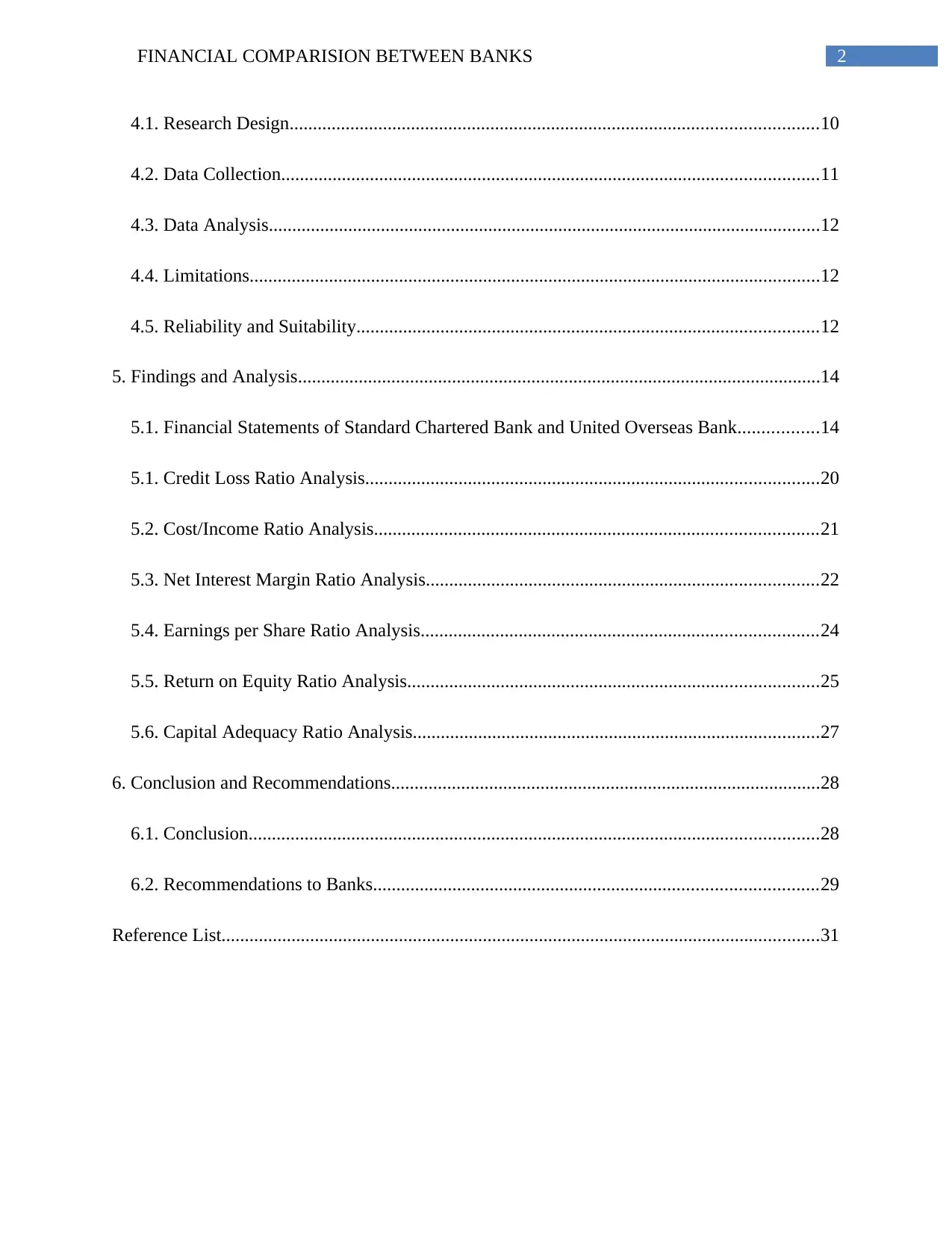
2FINANCIAL COMPARISION BETWEEN BANKS
4.1. Research Design.................................................................................................................10
4.2. Data Collection...................................................................................................................11
4.3. Data Analysis......................................................................................................................12
4.4. Limitations..........................................................................................................................12
4.5. Reliability and Suitability...................................................................................................12
5. Findings and Analysis................................................................................................................14
5.1. Financial Statements of Standard Chartered Bank and United Overseas Bank.................14
5.1. Credit Loss Ratio Analysis.................................................................................................20
5.2. Cost/Income Ratio Analysis...............................................................................................21
5.3. Net Interest Margin Ratio Analysis....................................................................................22
5.4. Earnings per Share Ratio Analysis.....................................................................................24
5.5. Return on Equity Ratio Analysis........................................................................................25
5.6. Capital Adequacy Ratio Analysis.......................................................................................27
6. Conclusion and Recommendations............................................................................................28
6.1. Conclusion..........................................................................................................................28
6.2. Recommendations to Banks...............................................................................................29
Reference List................................................................................................................................31
4.1. Research Design.................................................................................................................10
4.2. Data Collection...................................................................................................................11
4.3. Data Analysis......................................................................................................................12
4.4. Limitations..........................................................................................................................12
4.5. Reliability and Suitability...................................................................................................12
5. Findings and Analysis................................................................................................................14
5.1. Financial Statements of Standard Chartered Bank and United Overseas Bank.................14
5.1. Credit Loss Ratio Analysis.................................................................................................20
5.2. Cost/Income Ratio Analysis...............................................................................................21
5.3. Net Interest Margin Ratio Analysis....................................................................................22
5.4. Earnings per Share Ratio Analysis.....................................................................................24
5.5. Return on Equity Ratio Analysis........................................................................................25
5.6. Capital Adequacy Ratio Analysis.......................................................................................27
6. Conclusion and Recommendations............................................................................................28
6.1. Conclusion..........................................................................................................................28
6.2. Recommendations to Banks...............................................................................................29
Reference List................................................................................................................................31
⊘ This is a preview!⊘
Do you want full access?
Subscribe today to unlock all pages.

Trusted by 1+ million students worldwide
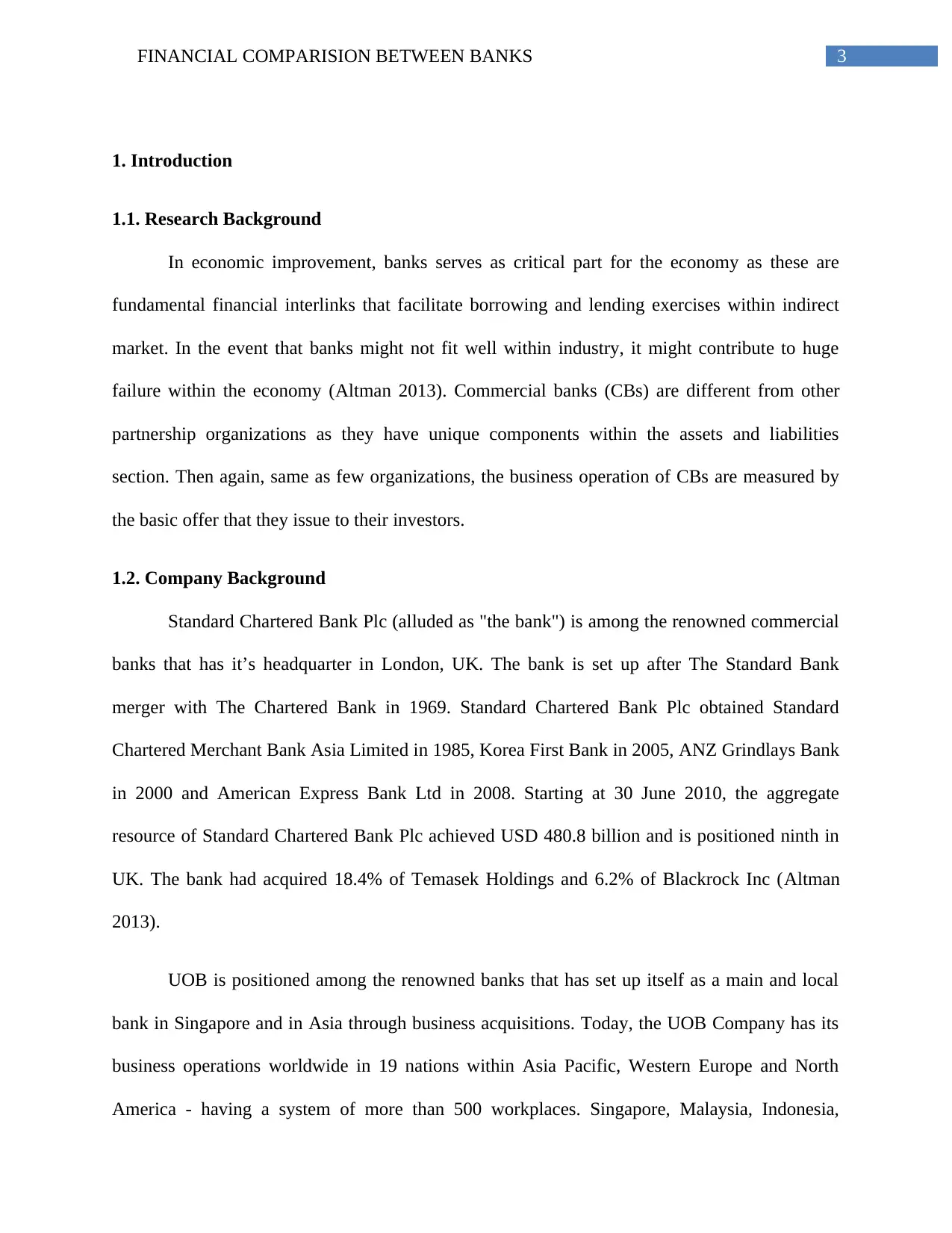
3FINANCIAL COMPARISION BETWEEN BANKS
1. Introduction
1.1. Research Background
In economic improvement, banks serves as critical part for the economy as these are
fundamental financial interlinks that facilitate borrowing and lending exercises within indirect
market. In the event that banks might not fit well within industry, it might contribute to huge
failure within the economy (Altman 2013). Commercial banks (CBs) are different from other
partnership organizations as they have unique components within the assets and liabilities
section. Then again, same as few organizations, the business operation of CBs are measured by
the basic offer that they issue to their investors.
1.2. Company Background
Standard Chartered Bank Plc (alluded as "the bank") is among the renowned commercial
banks that has it’s headquarter in London, UK. The bank is set up after The Standard Bank
merger with The Chartered Bank in 1969. Standard Chartered Bank Plc obtained Standard
Chartered Merchant Bank Asia Limited in 1985, Korea First Bank in 2005, ANZ Grindlays Bank
in 2000 and American Express Bank Ltd in 2008. Starting at 30 June 2010, the aggregate
resource of Standard Chartered Bank Plc achieved USD 480.8 billion and is positioned ninth in
UK. The bank had acquired 18.4% of Temasek Holdings and 6.2% of Blackrock Inc (Altman
2013).
UOB is positioned among the renowned banks that has set up itself as a main and local
bank in Singapore and in Asia through business acquisitions. Today, the UOB Company has its
business operations worldwide in 19 nations within Asia Pacific, Western Europe and North
America - having a system of more than 500 workplaces. Singapore, Malaysia, Indonesia,
1. Introduction
1.1. Research Background
In economic improvement, banks serves as critical part for the economy as these are
fundamental financial interlinks that facilitate borrowing and lending exercises within indirect
market. In the event that banks might not fit well within industry, it might contribute to huge
failure within the economy (Altman 2013). Commercial banks (CBs) are different from other
partnership organizations as they have unique components within the assets and liabilities
section. Then again, same as few organizations, the business operation of CBs are measured by
the basic offer that they issue to their investors.
1.2. Company Background
Standard Chartered Bank Plc (alluded as "the bank") is among the renowned commercial
banks that has it’s headquarter in London, UK. The bank is set up after The Standard Bank
merger with The Chartered Bank in 1969. Standard Chartered Bank Plc obtained Standard
Chartered Merchant Bank Asia Limited in 1985, Korea First Bank in 2005, ANZ Grindlays Bank
in 2000 and American Express Bank Ltd in 2008. Starting at 30 June 2010, the aggregate
resource of Standard Chartered Bank Plc achieved USD 480.8 billion and is positioned ninth in
UK. The bank had acquired 18.4% of Temasek Holdings and 6.2% of Blackrock Inc (Altman
2013).
UOB is positioned among the renowned banks that has set up itself as a main and local
bank in Singapore and in Asia through business acquisitions. Today, the UOB Company has its
business operations worldwide in 19 nations within Asia Pacific, Western Europe and North
America - having a system of more than 500 workplaces. Singapore, Malaysia, Indonesia,
Paraphrase This Document
Need a fresh take? Get an instant paraphrase of this document with our AI Paraphraser
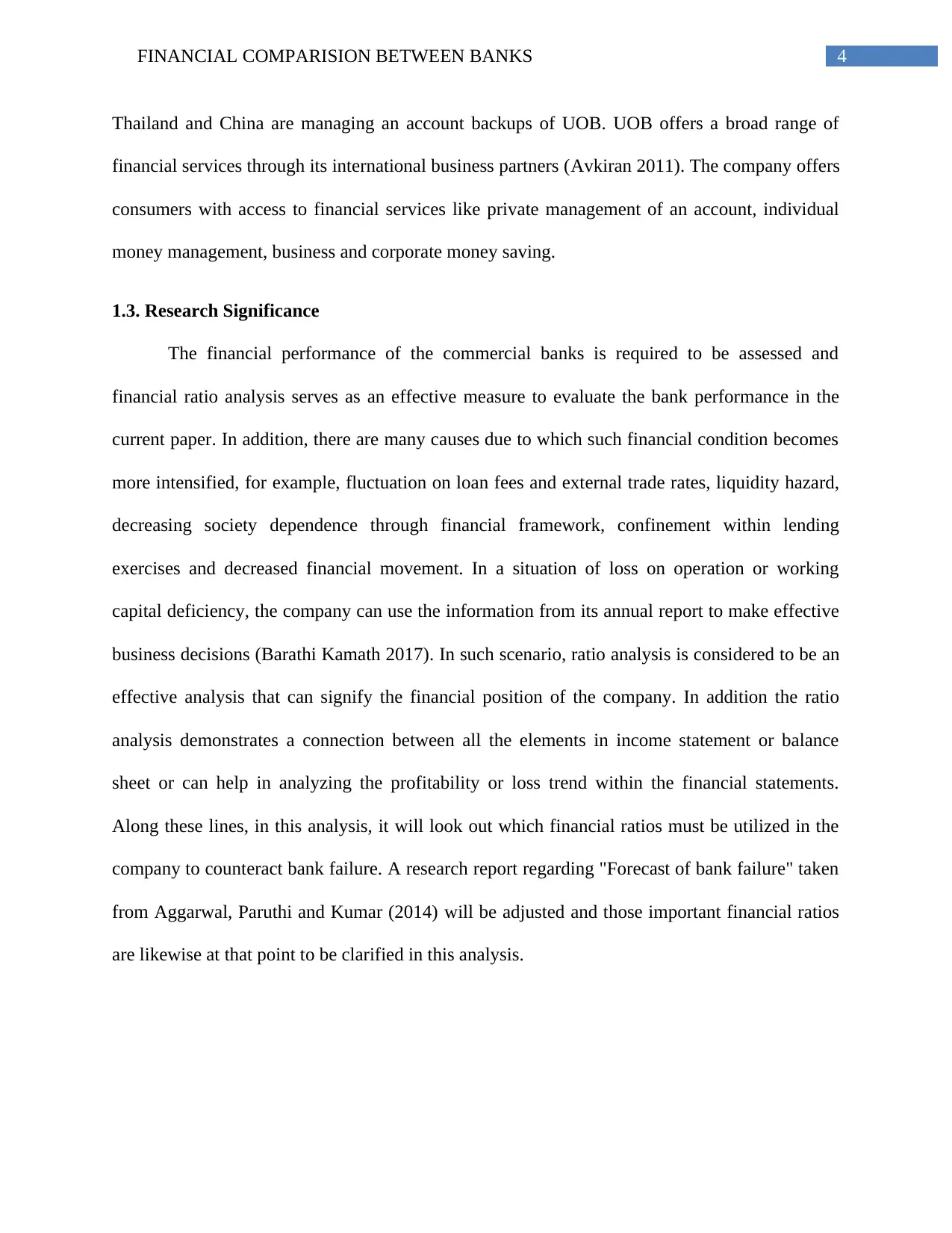
4FINANCIAL COMPARISION BETWEEN BANKS
Thailand and China are managing an account backups of UOB. UOB offers a broad range of
financial services through its international business partners (Avkiran 2011). The company offers
consumers with access to financial services like private management of an account, individual
money management, business and corporate money saving.
1.3. Research Significance
The financial performance of the commercial banks is required to be assessed and
financial ratio analysis serves as an effective measure to evaluate the bank performance in the
current paper. In addition, there are many causes due to which such financial condition becomes
more intensified, for example, fluctuation on loan fees and external trade rates, liquidity hazard,
decreasing society dependence through financial framework, confinement within lending
exercises and decreased financial movement. In a situation of loss on operation or working
capital deficiency, the company can use the information from its annual report to make effective
business decisions (Barathi Kamath 2017). In such scenario, ratio analysis is considered to be an
effective analysis that can signify the financial position of the company. In addition the ratio
analysis demonstrates a connection between all the elements in income statement or balance
sheet or can help in analyzing the profitability or loss trend within the financial statements.
Along these lines, in this analysis, it will look out which financial ratios must be utilized in the
company to counteract bank failure. A research report regarding "Forecast of bank failure" taken
from Aggarwal, Paruthi and Kumar (2014) will be adjusted and those important financial ratios
are likewise at that point to be clarified in this analysis.
Thailand and China are managing an account backups of UOB. UOB offers a broad range of
financial services through its international business partners (Avkiran 2011). The company offers
consumers with access to financial services like private management of an account, individual
money management, business and corporate money saving.
1.3. Research Significance
The financial performance of the commercial banks is required to be assessed and
financial ratio analysis serves as an effective measure to evaluate the bank performance in the
current paper. In addition, there are many causes due to which such financial condition becomes
more intensified, for example, fluctuation on loan fees and external trade rates, liquidity hazard,
decreasing society dependence through financial framework, confinement within lending
exercises and decreased financial movement. In a situation of loss on operation or working
capital deficiency, the company can use the information from its annual report to make effective
business decisions (Barathi Kamath 2017). In such scenario, ratio analysis is considered to be an
effective analysis that can signify the financial position of the company. In addition the ratio
analysis demonstrates a connection between all the elements in income statement or balance
sheet or can help in analyzing the profitability or loss trend within the financial statements.
Along these lines, in this analysis, it will look out which financial ratios must be utilized in the
company to counteract bank failure. A research report regarding "Forecast of bank failure" taken
from Aggarwal, Paruthi and Kumar (2014) will be adjusted and those important financial ratios
are likewise at that point to be clarified in this analysis.
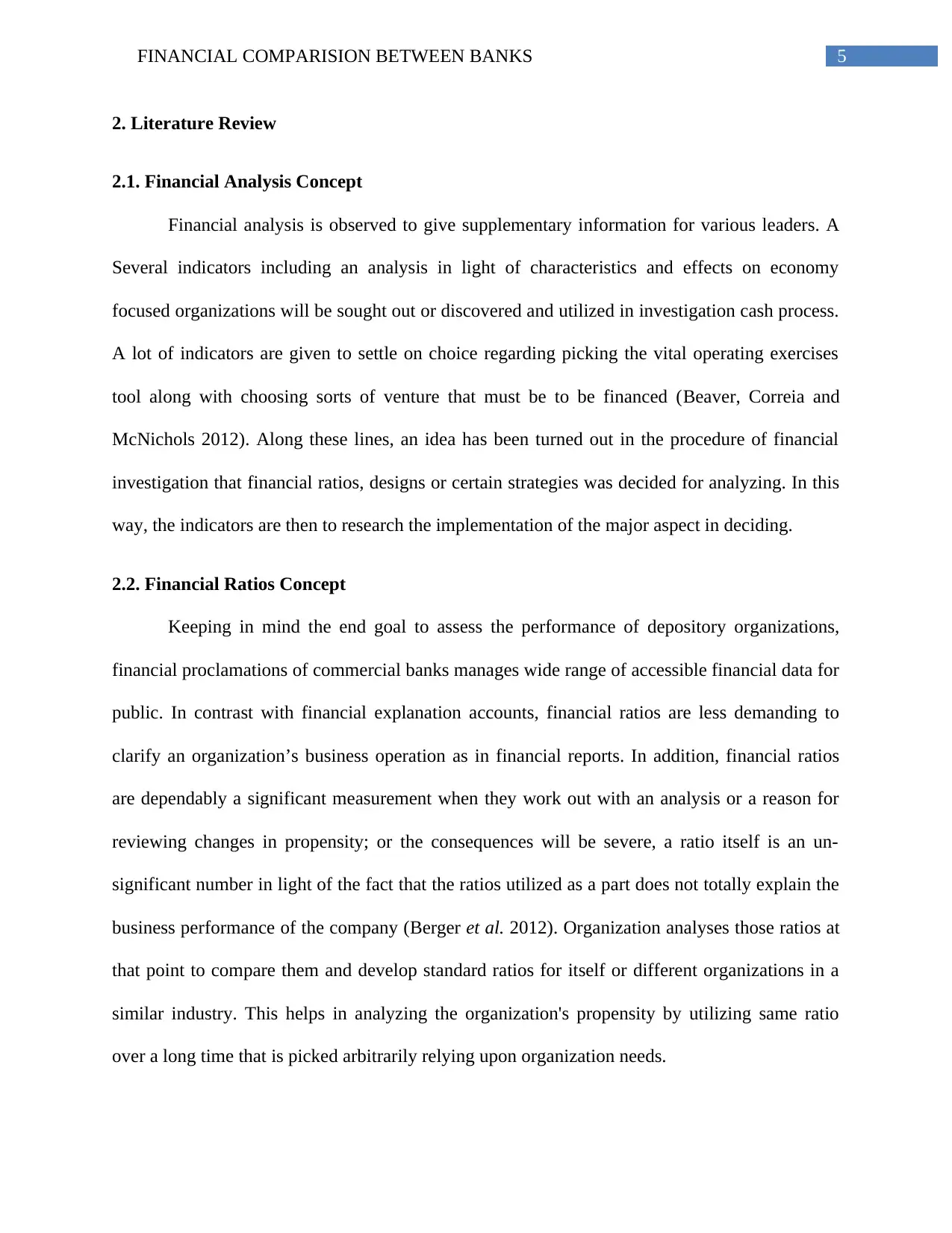
5FINANCIAL COMPARISION BETWEEN BANKS
2. Literature Review
2.1. Financial Analysis Concept
Financial analysis is observed to give supplementary information for various leaders. A
Several indicators including an analysis in light of characteristics and effects on economy
focused organizations will be sought out or discovered and utilized in investigation cash process.
A lot of indicators are given to settle on choice regarding picking the vital operating exercises
tool along with choosing sorts of venture that must be to be financed (Beaver, Correia and
McNichols 2012). Along these lines, an idea has been turned out in the procedure of financial
investigation that financial ratios, designs or certain strategies was decided for analyzing. In this
way, the indicators are then to research the implementation of the major aspect in deciding.
2.2. Financial Ratios Concept
Keeping in mind the end goal to assess the performance of depository organizations,
financial proclamations of commercial banks manages wide range of accessible financial data for
public. In contrast with financial explanation accounts, financial ratios are less demanding to
clarify an organization’s business operation as in financial reports. In addition, financial ratios
are dependably a significant measurement when they work out with an analysis or a reason for
reviewing changes in propensity; or the consequences will be severe, a ratio itself is an un-
significant number in light of the fact that the ratios utilized as a part does not totally explain the
business performance of the company (Berger et al. 2012). Organization analyses those ratios at
that point to compare them and develop standard ratios for itself or different organizations in a
similar industry. This helps in analyzing the organization's propensity by utilizing same ratio
over a long time that is picked arbitrarily relying upon organization needs.
2. Literature Review
2.1. Financial Analysis Concept
Financial analysis is observed to give supplementary information for various leaders. A
Several indicators including an analysis in light of characteristics and effects on economy
focused organizations will be sought out or discovered and utilized in investigation cash process.
A lot of indicators are given to settle on choice regarding picking the vital operating exercises
tool along with choosing sorts of venture that must be to be financed (Beaver, Correia and
McNichols 2012). Along these lines, an idea has been turned out in the procedure of financial
investigation that financial ratios, designs or certain strategies was decided for analyzing. In this
way, the indicators are then to research the implementation of the major aspect in deciding.
2.2. Financial Ratios Concept
Keeping in mind the end goal to assess the performance of depository organizations,
financial proclamations of commercial banks manages wide range of accessible financial data for
public. In contrast with financial explanation accounts, financial ratios are less demanding to
clarify an organization’s business operation as in financial reports. In addition, financial ratios
are dependably a significant measurement when they work out with an analysis or a reason for
reviewing changes in propensity; or the consequences will be severe, a ratio itself is an un-
significant number in light of the fact that the ratios utilized as a part does not totally explain the
business performance of the company (Berger et al. 2012). Organization analyses those ratios at
that point to compare them and develop standard ratios for itself or different organizations in a
similar industry. This helps in analyzing the organization's propensity by utilizing same ratio
over a long time that is picked arbitrarily relying upon organization needs.
⊘ This is a preview!⊘
Do you want full access?
Subscribe today to unlock all pages.

Trusted by 1+ million students worldwide
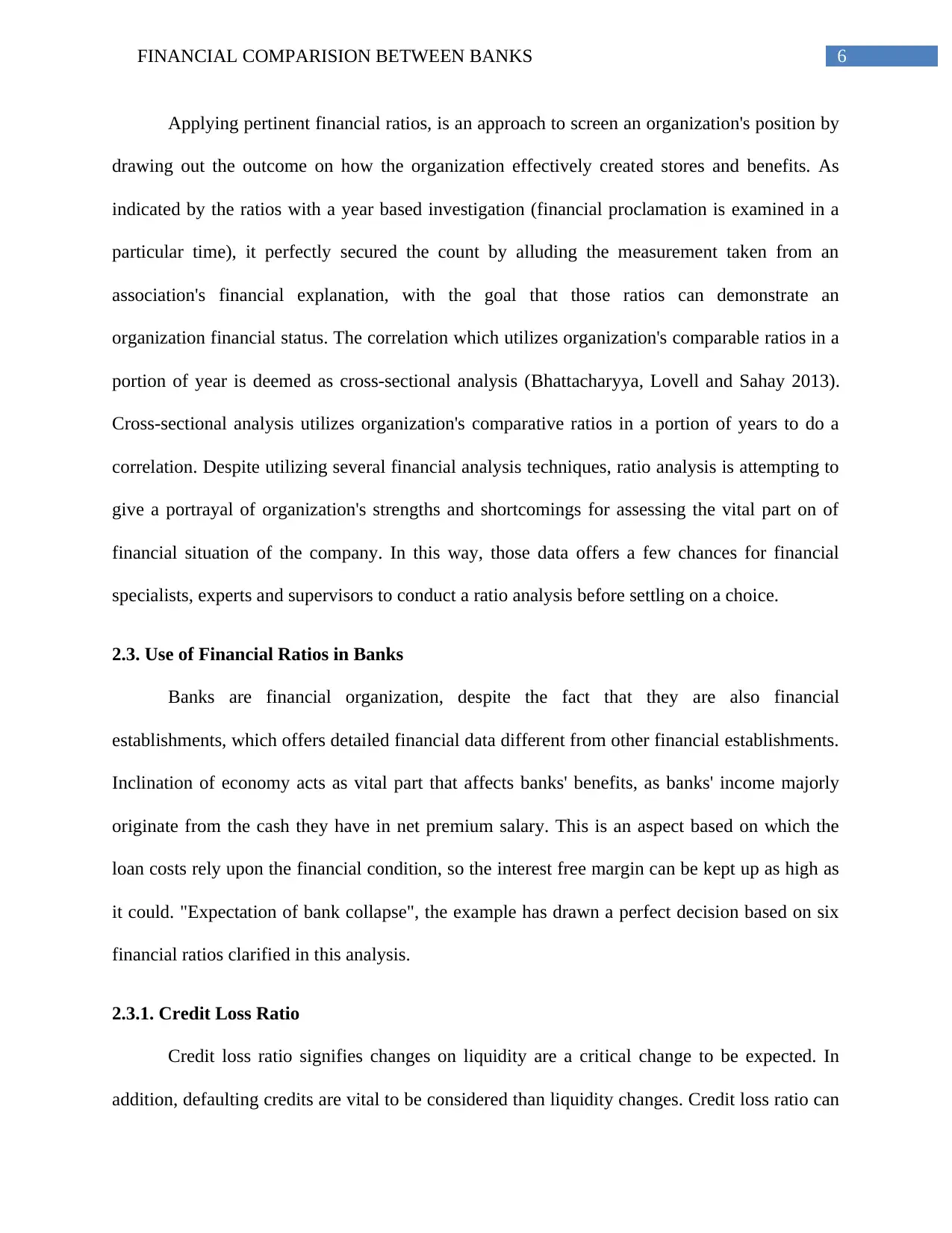
6FINANCIAL COMPARISION BETWEEN BANKS
Applying pertinent financial ratios, is an approach to screen an organization's position by
drawing out the outcome on how the organization effectively created stores and benefits. As
indicated by the ratios with a year based investigation (financial proclamation is examined in a
particular time), it perfectly secured the count by alluding the measurement taken from an
association's financial explanation, with the goal that those ratios can demonstrate an
organization financial status. The correlation which utilizes organization's comparable ratios in a
portion of year is deemed as cross-sectional analysis (Bhattacharyya, Lovell and Sahay 2013).
Cross-sectional analysis utilizes organization's comparative ratios in a portion of years to do a
correlation. Despite utilizing several financial analysis techniques, ratio analysis is attempting to
give a portrayal of organization's strengths and shortcomings for assessing the vital part on of
financial situation of the company. In this way, those data offers a few chances for financial
specialists, experts and supervisors to conduct a ratio analysis before settling on a choice.
2.3. Use of Financial Ratios in Banks
Banks are financial organization, despite the fact that they are also financial
establishments, which offers detailed financial data different from other financial establishments.
Inclination of economy acts as vital part that affects banks' benefits, as banks' income majorly
originate from the cash they have in net premium salary. This is an aspect based on which the
loan costs rely upon the financial condition, so the interest free margin can be kept up as high as
it could. "Expectation of bank collapse", the example has drawn a perfect decision based on six
financial ratios clarified in this analysis.
2.3.1. Credit Loss Ratio
Credit loss ratio signifies changes on liquidity are a critical change to be expected. In
addition, defaulting credits are vital to be considered than liquidity changes. Credit loss ratio can
Applying pertinent financial ratios, is an approach to screen an organization's position by
drawing out the outcome on how the organization effectively created stores and benefits. As
indicated by the ratios with a year based investigation (financial proclamation is examined in a
particular time), it perfectly secured the count by alluding the measurement taken from an
association's financial explanation, with the goal that those ratios can demonstrate an
organization financial status. The correlation which utilizes organization's comparable ratios in a
portion of year is deemed as cross-sectional analysis (Bhattacharyya, Lovell and Sahay 2013).
Cross-sectional analysis utilizes organization's comparative ratios in a portion of years to do a
correlation. Despite utilizing several financial analysis techniques, ratio analysis is attempting to
give a portrayal of organization's strengths and shortcomings for assessing the vital part on of
financial situation of the company. In this way, those data offers a few chances for financial
specialists, experts and supervisors to conduct a ratio analysis before settling on a choice.
2.3. Use of Financial Ratios in Banks
Banks are financial organization, despite the fact that they are also financial
establishments, which offers detailed financial data different from other financial establishments.
Inclination of economy acts as vital part that affects banks' benefits, as banks' income majorly
originate from the cash they have in net premium salary. This is an aspect based on which the
loan costs rely upon the financial condition, so the interest free margin can be kept up as high as
it could. "Expectation of bank collapse", the example has drawn a perfect decision based on six
financial ratios clarified in this analysis.
2.3.1. Credit Loss Ratio
Credit loss ratio signifies changes on liquidity are a critical change to be expected. In
addition, defaulting credits are vital to be considered than liquidity changes. Credit loss ratio can
Paraphrase This Document
Need a fresh take? Get an instant paraphrase of this document with our AI Paraphraser
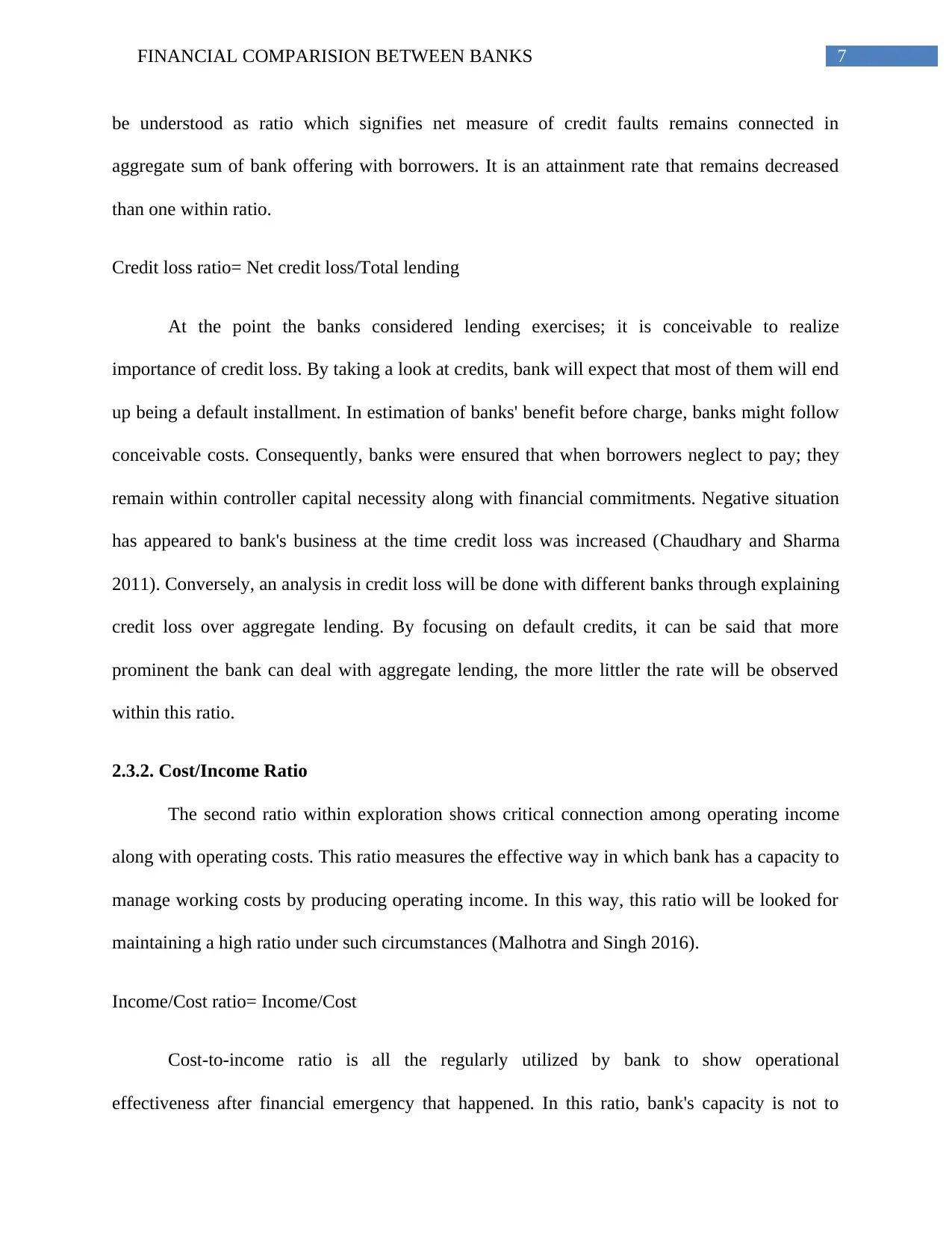
7FINANCIAL COMPARISION BETWEEN BANKS
be understood as ratio which signifies net measure of credit faults remains connected in
aggregate sum of bank offering with borrowers. It is an attainment rate that remains decreased
than one within ratio.
Credit loss ratio= Net credit loss/Total lending
At the point the banks considered lending exercises; it is conceivable to realize
importance of credit loss. By taking a look at credits, bank will expect that most of them will end
up being a default installment. In estimation of banks' benefit before charge, banks might follow
conceivable costs. Consequently, banks were ensured that when borrowers neglect to pay; they
remain within controller capital necessity along with financial commitments. Negative situation
has appeared to bank's business at the time credit loss was increased (Chaudhary and Sharma
2011). Conversely, an analysis in credit loss will be done with different banks through explaining
credit loss over aggregate lending. By focusing on default credits, it can be said that more
prominent the bank can deal with aggregate lending, the more littler the rate will be observed
within this ratio.
2.3.2. Cost/Income Ratio
The second ratio within exploration shows critical connection among operating income
along with operating costs. This ratio measures the effective way in which bank has a capacity to
manage working costs by producing operating income. In this way, this ratio will be looked for
maintaining a high ratio under such circumstances (Malhotra and Singh 2016).
Income/Cost ratio= Income/Cost
Cost-to-income ratio is all the regularly utilized by bank to show operational
effectiveness after financial emergency that happened. In this ratio, bank's capacity is not to
be understood as ratio which signifies net measure of credit faults remains connected in
aggregate sum of bank offering with borrowers. It is an attainment rate that remains decreased
than one within ratio.
Credit loss ratio= Net credit loss/Total lending
At the point the banks considered lending exercises; it is conceivable to realize
importance of credit loss. By taking a look at credits, bank will expect that most of them will end
up being a default installment. In estimation of banks' benefit before charge, banks might follow
conceivable costs. Consequently, banks were ensured that when borrowers neglect to pay; they
remain within controller capital necessity along with financial commitments. Negative situation
has appeared to bank's business at the time credit loss was increased (Chaudhary and Sharma
2011). Conversely, an analysis in credit loss will be done with different banks through explaining
credit loss over aggregate lending. By focusing on default credits, it can be said that more
prominent the bank can deal with aggregate lending, the more littler the rate will be observed
within this ratio.
2.3.2. Cost/Income Ratio
The second ratio within exploration shows critical connection among operating income
along with operating costs. This ratio measures the effective way in which bank has a capacity to
manage working costs by producing operating income. In this way, this ratio will be looked for
maintaining a high ratio under such circumstances (Malhotra and Singh 2016).
Income/Cost ratio= Income/Cost
Cost-to-income ratio is all the regularly utilized by bank to show operational
effectiveness after financial emergency that happened. In this ratio, bank's capacity is not to
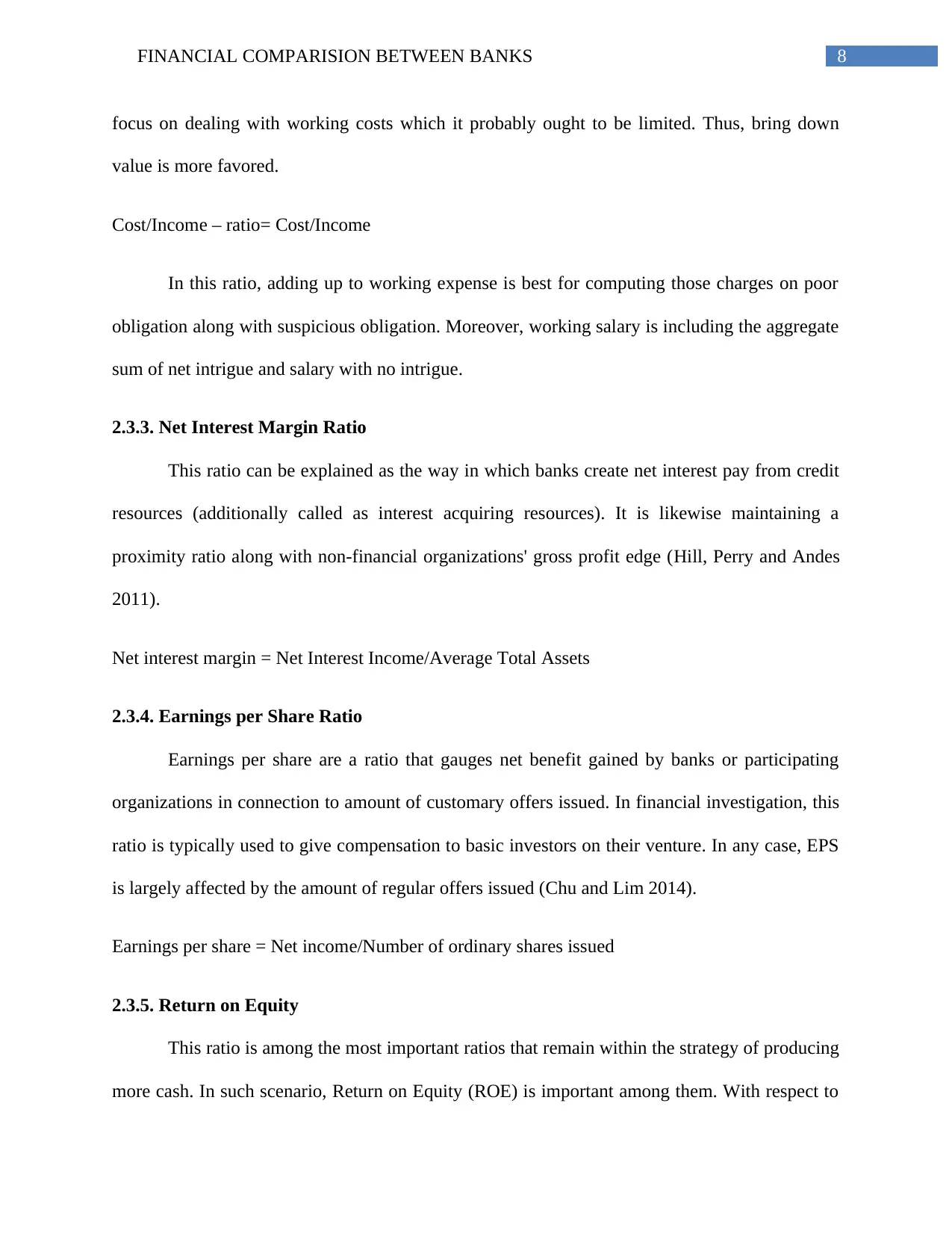
8FINANCIAL COMPARISION BETWEEN BANKS
focus on dealing with working costs which it probably ought to be limited. Thus, bring down
value is more favored.
Cost/Income – ratio= Cost/Income
In this ratio, adding up to working expense is best for computing those charges on poor
obligation along with suspicious obligation. Moreover, working salary is including the aggregate
sum of net intrigue and salary with no intrigue.
2.3.3. Net Interest Margin Ratio
This ratio can be explained as the way in which banks create net interest pay from credit
resources (additionally called as interest acquiring resources). It is likewise maintaining a
proximity ratio along with non-financial organizations' gross profit edge (Hill, Perry and Andes
2011).
Net interest margin = Net Interest Income/Average Total Assets
2.3.4. Earnings per Share Ratio
Earnings per share are a ratio that gauges net benefit gained by banks or participating
organizations in connection to amount of customary offers issued. In financial investigation, this
ratio is typically used to give compensation to basic investors on their venture. In any case, EPS
is largely affected by the amount of regular offers issued (Chu and Lim 2014).
Earnings per share = Net income/Number of ordinary shares issued
2.3.5. Return on Equity
This ratio is among the most important ratios that remain within the strategy of producing
more cash. In such scenario, Return on Equity (ROE) is important among them. With respect to
focus on dealing with working costs which it probably ought to be limited. Thus, bring down
value is more favored.
Cost/Income – ratio= Cost/Income
In this ratio, adding up to working expense is best for computing those charges on poor
obligation along with suspicious obligation. Moreover, working salary is including the aggregate
sum of net intrigue and salary with no intrigue.
2.3.3. Net Interest Margin Ratio
This ratio can be explained as the way in which banks create net interest pay from credit
resources (additionally called as interest acquiring resources). It is likewise maintaining a
proximity ratio along with non-financial organizations' gross profit edge (Hill, Perry and Andes
2011).
Net interest margin = Net Interest Income/Average Total Assets
2.3.4. Earnings per Share Ratio
Earnings per share are a ratio that gauges net benefit gained by banks or participating
organizations in connection to amount of customary offers issued. In financial investigation, this
ratio is typically used to give compensation to basic investors on their venture. In any case, EPS
is largely affected by the amount of regular offers issued (Chu and Lim 2014).
Earnings per share = Net income/Number of ordinary shares issued
2.3.5. Return on Equity
This ratio is among the most important ratios that remain within the strategy of producing
more cash. In such scenario, Return on Equity (ROE) is important among them. With respect to
⊘ This is a preview!⊘
Do you want full access?
Subscribe today to unlock all pages.

Trusted by 1+ million students worldwide
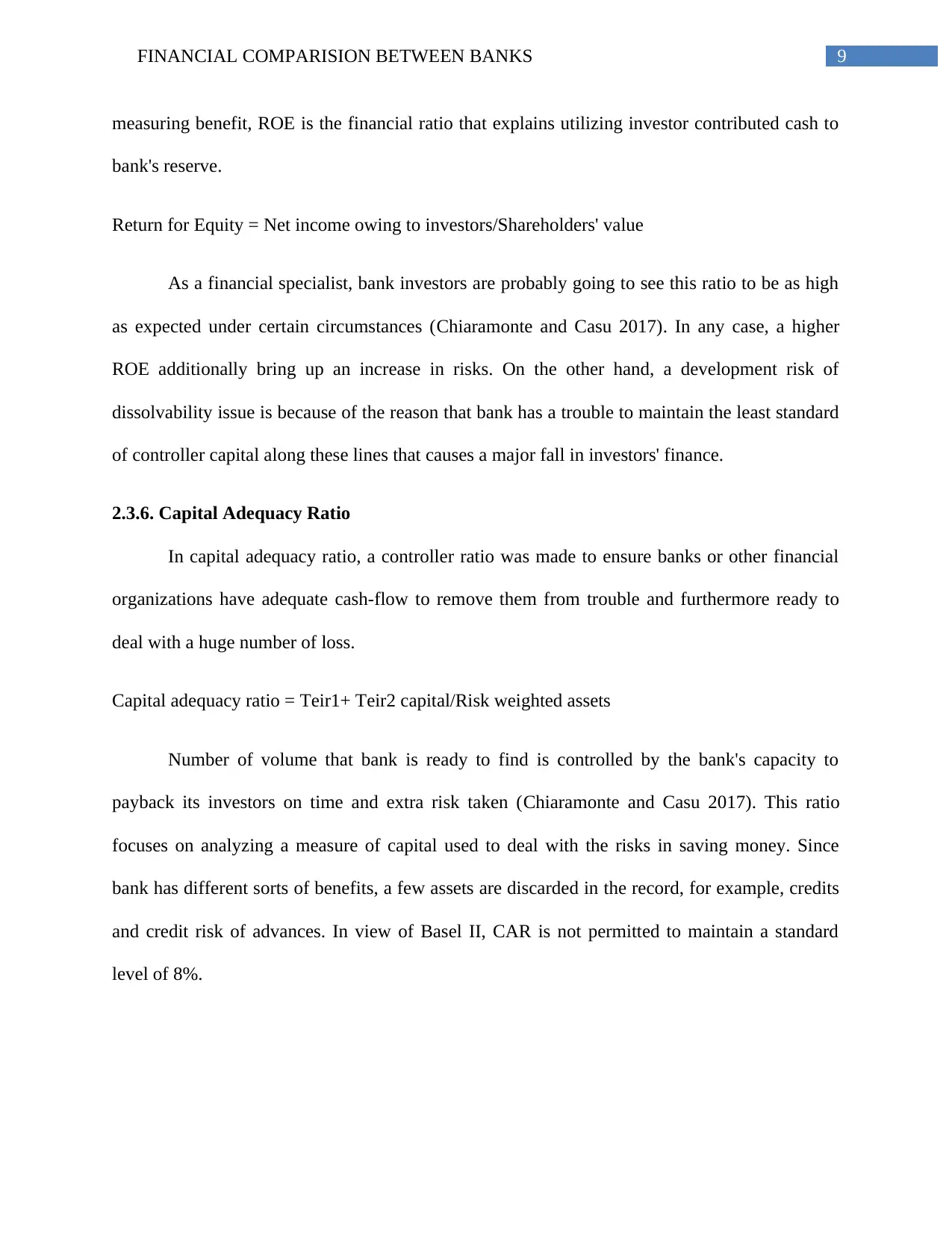
9FINANCIAL COMPARISION BETWEEN BANKS
measuring benefit, ROE is the financial ratio that explains utilizing investor contributed cash to
bank's reserve.
Return for Equity = Net income owing to investors/Shareholders' value
As a financial specialist, bank investors are probably going to see this ratio to be as high
as expected under certain circumstances (Chiaramonte and Casu 2017). In any case, a higher
ROE additionally bring up an increase in risks. On the other hand, a development risk of
dissolvability issue is because of the reason that bank has a trouble to maintain the least standard
of controller capital along these lines that causes a major fall in investors' finance.
2.3.6. Capital Adequacy Ratio
In capital adequacy ratio, a controller ratio was made to ensure banks or other financial
organizations have adequate cash-flow to remove them from trouble and furthermore ready to
deal with a huge number of loss.
Capital adequacy ratio = Teir1+ Teir2 capital/Risk weighted assets
Number of volume that bank is ready to find is controlled by the bank's capacity to
payback its investors on time and extra risk taken (Chiaramonte and Casu 2017). This ratio
focuses on analyzing a measure of capital used to deal with the risks in saving money. Since
bank has different sorts of benefits, a few assets are discarded in the record, for example, credits
and credit risk of advances. In view of Basel II, CAR is not permitted to maintain a standard
level of 8%.
measuring benefit, ROE is the financial ratio that explains utilizing investor contributed cash to
bank's reserve.
Return for Equity = Net income owing to investors/Shareholders' value
As a financial specialist, bank investors are probably going to see this ratio to be as high
as expected under certain circumstances (Chiaramonte and Casu 2017). In any case, a higher
ROE additionally bring up an increase in risks. On the other hand, a development risk of
dissolvability issue is because of the reason that bank has a trouble to maintain the least standard
of controller capital along these lines that causes a major fall in investors' finance.
2.3.6. Capital Adequacy Ratio
In capital adequacy ratio, a controller ratio was made to ensure banks or other financial
organizations have adequate cash-flow to remove them from trouble and furthermore ready to
deal with a huge number of loss.
Capital adequacy ratio = Teir1+ Teir2 capital/Risk weighted assets
Number of volume that bank is ready to find is controlled by the bank's capacity to
payback its investors on time and extra risk taken (Chiaramonte and Casu 2017). This ratio
focuses on analyzing a measure of capital used to deal with the risks in saving money. Since
bank has different sorts of benefits, a few assets are discarded in the record, for example, credits
and credit risk of advances. In view of Basel II, CAR is not permitted to maintain a standard
level of 8%.
Paraphrase This Document
Need a fresh take? Get an instant paraphrase of this document with our AI Paraphraser
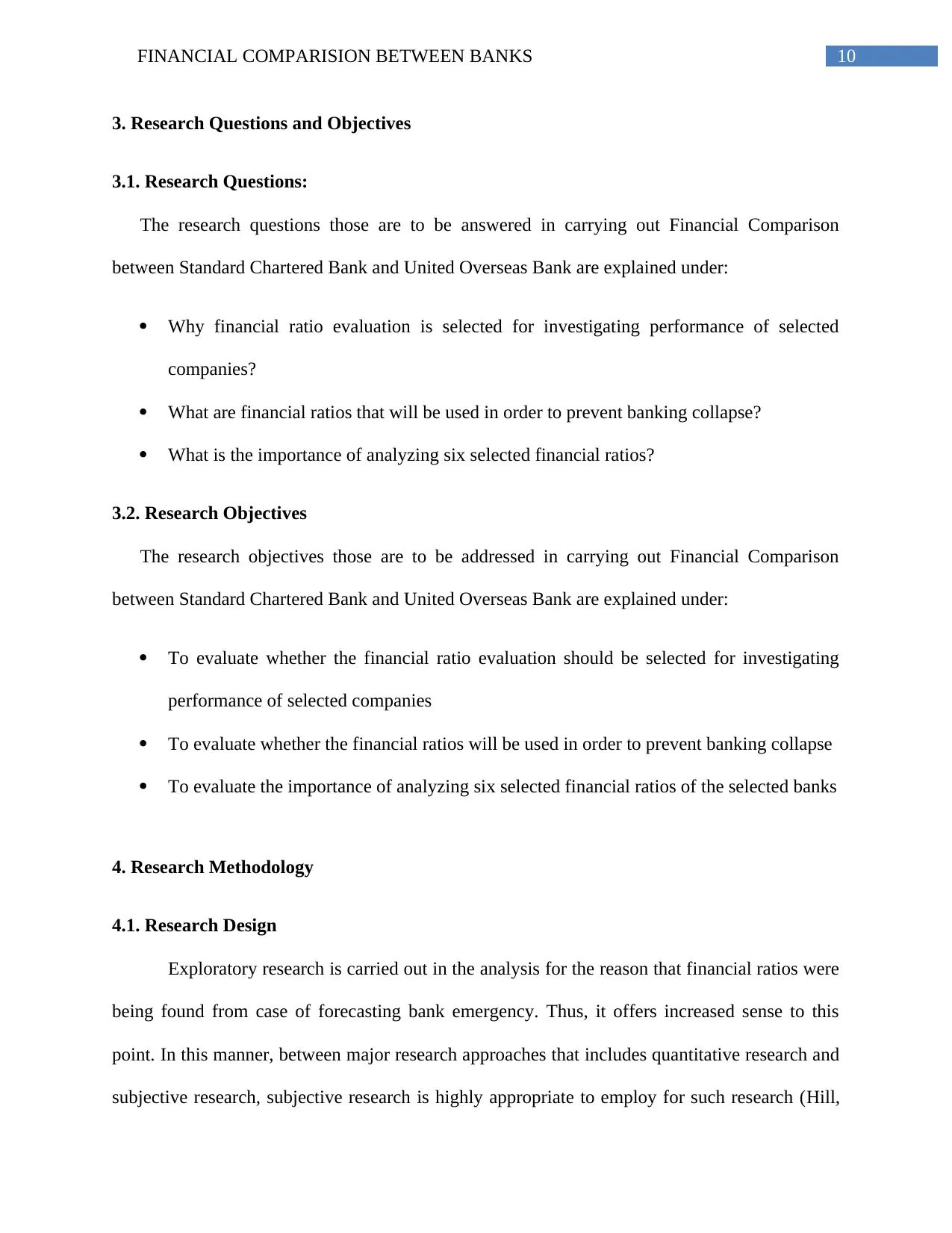
10FINANCIAL COMPARISION BETWEEN BANKS
3. Research Questions and Objectives
3.1. Research Questions:
The research questions those are to be answered in carrying out Financial Comparison
between Standard Chartered Bank and United Overseas Bank are explained under:
Why financial ratio evaluation is selected for investigating performance of selected
companies?
What are financial ratios that will be used in order to prevent banking collapse?
What is the importance of analyzing six selected financial ratios?
3.2. Research Objectives
The research objectives those are to be addressed in carrying out Financial Comparison
between Standard Chartered Bank and United Overseas Bank are explained under:
To evaluate whether the financial ratio evaluation should be selected for investigating
performance of selected companies
To evaluate whether the financial ratios will be used in order to prevent banking collapse
To evaluate the importance of analyzing six selected financial ratios of the selected banks
4. Research Methodology
4.1. Research Design
Exploratory research is carried out in the analysis for the reason that financial ratios were
being found from case of forecasting bank emergency. Thus, it offers increased sense to this
point. In this manner, between major research approaches that includes quantitative research and
subjective research, subjective research is highly appropriate to employ for such research (Hill,
3. Research Questions and Objectives
3.1. Research Questions:
The research questions those are to be answered in carrying out Financial Comparison
between Standard Chartered Bank and United Overseas Bank are explained under:
Why financial ratio evaluation is selected for investigating performance of selected
companies?
What are financial ratios that will be used in order to prevent banking collapse?
What is the importance of analyzing six selected financial ratios?
3.2. Research Objectives
The research objectives those are to be addressed in carrying out Financial Comparison
between Standard Chartered Bank and United Overseas Bank are explained under:
To evaluate whether the financial ratio evaluation should be selected for investigating
performance of selected companies
To evaluate whether the financial ratios will be used in order to prevent banking collapse
To evaluate the importance of analyzing six selected financial ratios of the selected banks
4. Research Methodology
4.1. Research Design
Exploratory research is carried out in the analysis for the reason that financial ratios were
being found from case of forecasting bank emergency. Thus, it offers increased sense to this
point. In this manner, between major research approaches that includes quantitative research and
subjective research, subjective research is highly appropriate to employ for such research (Hill,
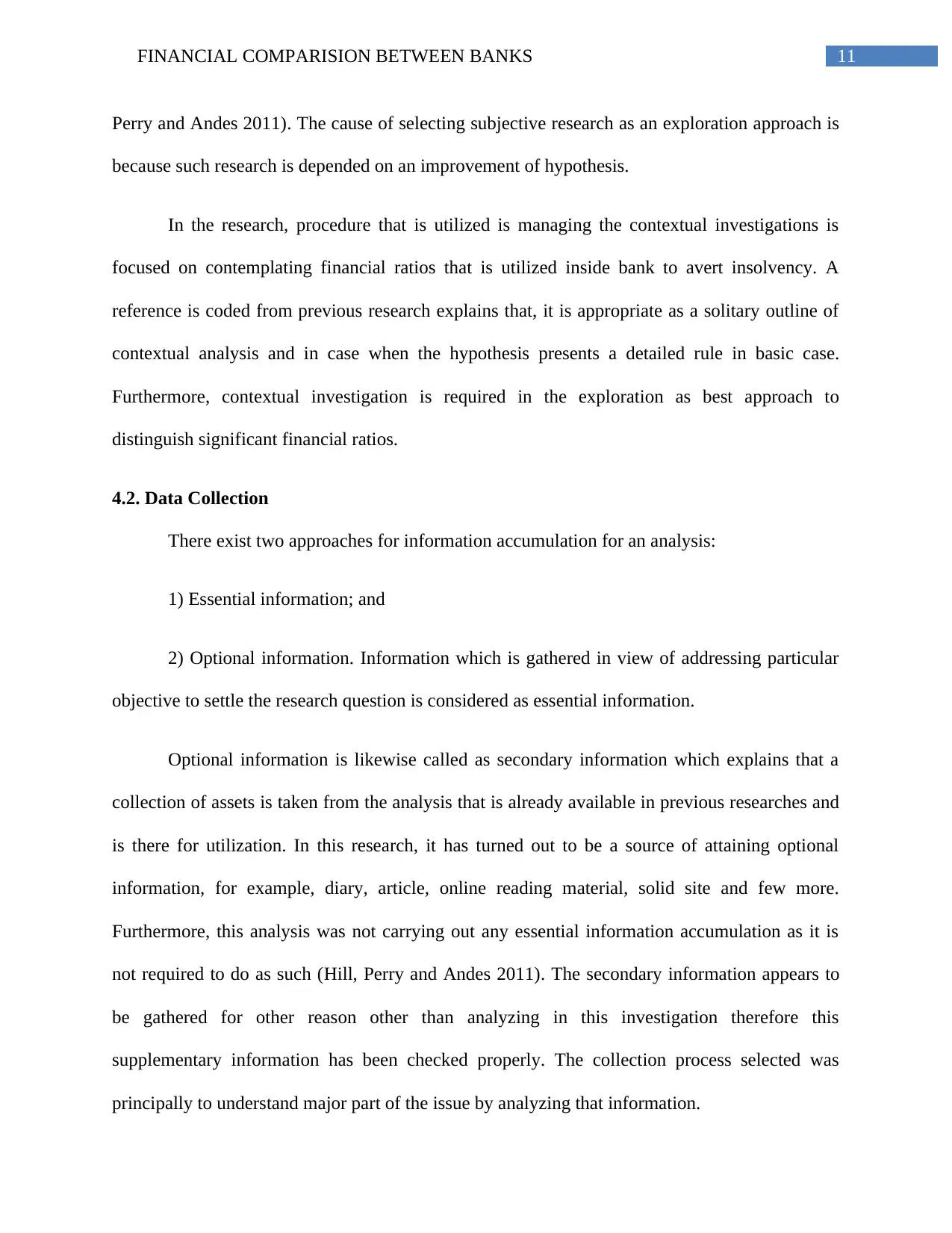
11FINANCIAL COMPARISION BETWEEN BANKS
Perry and Andes 2011). The cause of selecting subjective research as an exploration approach is
because such research is depended on an improvement of hypothesis.
In the research, procedure that is utilized is managing the contextual investigations is
focused on contemplating financial ratios that is utilized inside bank to avert insolvency. A
reference is coded from previous research explains that, it is appropriate as a solitary outline of
contextual analysis and in case when the hypothesis presents a detailed rule in basic case.
Furthermore, contextual investigation is required in the exploration as best approach to
distinguish significant financial ratios.
4.2. Data Collection
There exist two approaches for information accumulation for an analysis:
1) Essential information; and
2) Optional information. Information which is gathered in view of addressing particular
objective to settle the research question is considered as essential information.
Optional information is likewise called as secondary information which explains that a
collection of assets is taken from the analysis that is already available in previous researches and
is there for utilization. In this research, it has turned out to be a source of attaining optional
information, for example, diary, article, online reading material, solid site and few more.
Furthermore, this analysis was not carrying out any essential information accumulation as it is
not required to do as such (Hill, Perry and Andes 2011). The secondary information appears to
be gathered for other reason other than analyzing in this investigation therefore this
supplementary information has been checked properly. The collection process selected was
principally to understand major part of the issue by analyzing that information.
Perry and Andes 2011). The cause of selecting subjective research as an exploration approach is
because such research is depended on an improvement of hypothesis.
In the research, procedure that is utilized is managing the contextual investigations is
focused on contemplating financial ratios that is utilized inside bank to avert insolvency. A
reference is coded from previous research explains that, it is appropriate as a solitary outline of
contextual analysis and in case when the hypothesis presents a detailed rule in basic case.
Furthermore, contextual investigation is required in the exploration as best approach to
distinguish significant financial ratios.
4.2. Data Collection
There exist two approaches for information accumulation for an analysis:
1) Essential information; and
2) Optional information. Information which is gathered in view of addressing particular
objective to settle the research question is considered as essential information.
Optional information is likewise called as secondary information which explains that a
collection of assets is taken from the analysis that is already available in previous researches and
is there for utilization. In this research, it has turned out to be a source of attaining optional
information, for example, diary, article, online reading material, solid site and few more.
Furthermore, this analysis was not carrying out any essential information accumulation as it is
not required to do as such (Hill, Perry and Andes 2011). The secondary information appears to
be gathered for other reason other than analyzing in this investigation therefore this
supplementary information has been checked properly. The collection process selected was
principally to understand major part of the issue by analyzing that information.
⊘ This is a preview!⊘
Do you want full access?
Subscribe today to unlock all pages.

Trusted by 1+ million students worldwide
1 out of 33
Your All-in-One AI-Powered Toolkit for Academic Success.
+13062052269
info@desklib.com
Available 24*7 on WhatsApp / Email
![[object Object]](/_next/static/media/star-bottom.7253800d.svg)
Unlock your academic potential
Copyright © 2020–2025 A2Z Services. All Rights Reserved. Developed and managed by ZUCOL.